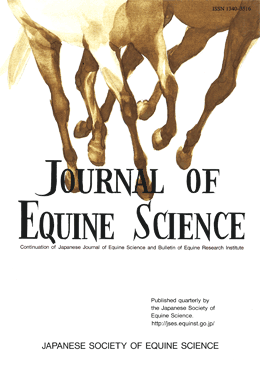
- Issue 4 Pages 101-
- Issue 3 Pages 61-
- Issue 2 Pages 21-
- Issue 1 Pages 1-
- |<
- <
- 1
- >
- >|
-
Mioko MASUDA, Akihiro NIKADORI, Emi NIKADORI, Naoya UCHIDA, Yoshimasa ...Article type: —Full Paper—
2023 Volume 34 Issue 1 Pages 1-6
Published: 2023
Released on J-STAGE: March 24, 2023
JOURNAL OPEN ACCESSThe Miyako horse is a native Japanese horse breed. As with other native Japanese horses, the number of Miyako horses decreased due to mechanization and motorization, which reduced their roles, with just 14 in 1980. Although their population had increased to 55 horses by 2021, a further increase in their numbers is required to avoid extinction. Recently, their breeding has involved natural mating during group grazing; therefore, pedigree management has been difficult, and individual identification has been inconclusive. With the aim of formulating an effective breeding plan, this study used microsatellites to confirm parent-offspring relationships and evaluate the genetic diversity over time. First, the combination of microsatellite genotypes identified misunderstood parent-offspring relationships in 35.3% of the existing individuals, and a correct family tree was reconstructed. Next, the number of alleles and observed and expected values of heterozygosity were calculated separately for the populations during periods of 1998–2012 and 2013–2020. The values were 4.2, 0.705, and 0.653 and 3.9, 0.633, and 0.603, respectively, indicating that genetic diversity according to all indices decreased during period of 2013–2020. This was probably because of the bias of stallions in the 2013–2020 population. Errors in pedigree information in a small population such as Miyako horses could increase the risk of inbreeding, and confirmation of parent-offspring relationships using genotypes may be beneficial. Additionally, to maintain diversity in future breeding, it is important to avoid bias, particularly among stallions, and to ensure offspring of various individuals who are as distantly related to each other as possible.
View full abstractDownload PDF (1050K) -
Ian MAWHINNEY, Anne BOLLARDArticle type: —Full Paper—
2023 Volume 34 Issue 1 Pages 7-12
Published: 2023
Released on J-STAGE: March 24, 2023
JOURNAL OPEN ACCESSDetection of Taylorella equigenitalis (CEMO) in the horse uses genital swabs. These swabs traditionally have been put in Amies charcoal transport medium for detection by culture but are also used for PCR. We determined the suitability of swabs without transport medium (Dry swabs) for CEMO PCR compared to swabs in Amies charcoal transport medium. The experiment was a factorial design using swab type and dilution of organism in culture suspensions, done in two parts. Simulated genital swabs were prepared in the laboratory by dipping in pairs into culture suspensions containing T. equigenitalis with or without other organisms, and then inserting them into a sleeve either with or without transport medium. In study 1, the difference in Ct value for the two swab types was compared. In study 2 genital swab material was then also added to culture suspensions and the swab types again compared. The swabs were tested by a validated quantitative PCR method. The Ct value of the PCR test was used as the measure for comparison, and the effect of variables assessed with linear regression. There was an 7.7% (6.5–8.9) higher mean Ct value of TM versus Dry swabs (P<0.001) overall. The Ct difference was more marked at higher dilutions. Addition of genital swab material had no effect on the Ct value. Dry swabs perform at least as well for PCR as swabs in Amies charcoal transport medium, especially when relatively low numbers of organism are present, and are advantageous for routine sampling when culture is not being used.
View full abstractDownload PDF (669K)
-
Hiroshi BANNAI, Yoshinori KAMBAYASHI, Minoru OHTA, Manabu NEMOTO, Koji ...Article type: —Note—
2023 Volume 34 Issue 1 Pages 13-18
Published: 2023
Released on J-STAGE: March 24, 2023
JOURNAL OPEN ACCESSTo assess the prevalence of equine coronavirus infection in riding horses, virus-neutralizing tests were performed on serum and saliva samples collected at four facilities in Japan. Seropositivity rates ranged from 79.2% to 94.6%, suggesting widespread circulation of the virus in these populations. Antibody prevalence in saliva samples from two facilities that had experienced outbreaks in the previous year (67.6% and 71.4%) was significantly higher than at the other facilities without reported outbreaks (41.7% and 45.2%, P<0.05). The presence of salivary antibodies in a high proportion of horses is therefore suggestive of recent exposure to the virus.
View full abstractDownload PDF (587K)
-
2023 Volume 34 Issue 1 Pages 19-
Published: 2023
Released on J-STAGE: March 24, 2023
JOURNAL OPEN ACCESSDownload PDF (1304K)
- |<
- <
- 1
- >
- >|